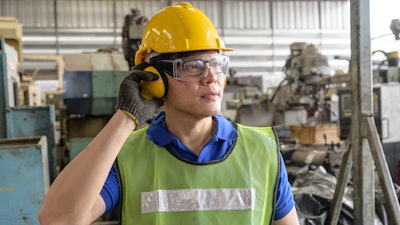
HR leaders within manufacturing have long been navigating the ongoing challenges of finding and retaining skilled workers. A survey from the UKG Workforce Institute revealed that despite a healthy growth in demand for manufactured goods and services, 76 percent of U.S. manufacturers are still struggling to fill critical labor gaps. Not only that, but 66 percent of those U.S. manufacturers say that it now takes longer to fill these positions than it did in previous years.
Many companies have begun exploring recruiting strategies such as partnering with educational institutions to train and source skilled workers early in their career, and also offering competitive compensation packages. However, more is needed, not only to attract workers but also to increase loyalty and satisfaction. That's why employers should consider promoting a safer workplace as a crucial part of their overall hiring and onboarding strategy.
In Sterling’s Hiring Reimagined Industrial Report, 76 percent of job candidates in the manufacturing space reported that safety in the workplace was either very important or important, ranking higher than workplace flexibility and even pay and benefits. It's easy to understand why workplace safety is so important for candidates: employees are handling sensitive and potentially dangerous equipment as part of their role. In fact, in 2021, the manufacturing sector reported 385,100 injury and illness cases to the U.S. Bureau of Labor Statistics.
Not fostering a workplace built on trust and safety as part of the hiring process can be the difference between candidates choosing to work with one company over another. Below let's address three ways manufacturers can cultivate and promote workplace safety in order to find skilled workers and close critical labor gaps.
#1: Start with a Thorough Background Check
Creating a safer working environment starts well before the day a new hire arrives on the job. First conducting a thorough background check should serve manufacturing companies as the first line of defense in promoting workplace safety. It’s essential for manufacturers to validate upfront that candidates possess the qualifications, skills, and training to perform their job safely and effectively. These credentials can all be verified by conducting a thorough background check.
A background check solution designed for manufacturers, including services such as criminal background checks, pre-employment verifications, and drug and health screenings, among others, are fundamental in enabling workplace safety. Background checks tailored to the manufacturing industry can also reveal a candidate’s past incidents or infractions that could pose a risk to workplace safety.
These concerning factors could include a history of workplace accidents, substance abuse, or criminal offenses. Fortunately, learning this information can empower companies to make better-informed decisions about prospective employees, reducing potential risk before they can become safety liabilities. By conducting a thorough background check for these sensitive roles, manufacturing companies can show candidates their firm commitment to safety.
#2: Adhering to Regulatory Requirements
Not only can a robust background check program verify the qualifications and skills of workers, but they can also help companies comply with regulatory compliance at every stage of the hiring process, from verifying licenses and certifications to adhering to safety protocols. This can reassure both candidates and current employees that no corners are cut when it comes to adhering to regulatory requirements.
One area where manufacturers can benefit from staying in the know about the latest regulatory requirements is when hiring contractors. While not full-time employees, contract workers still require the qualifications and skills needed to safely complete projects. A background check program which can accommodate contract workers can further maintain and protect both employees and the company, further emphasizing an organization’s focus on prioritizing safety first in the workplace.
#3: Effective Onboarding Process
Promoting workplace safety shouldn’t stop after hiring someone. In the same UKG Workforce Institute survey, 3 in 5 manufacturing HR leaders have reported an increase in employee turnover (62 percent) and unfilled jobs (57 percent) over the prior year. Not only that, but most HR leaders say $20,000 to $40,000 is the average cost to replace a skilled frontline employee.
An effective onboarding process can help establish employee loyalty early into their new job while also helping to reduce employee turnover. In a recent Sterling report, HR’s Guide to Onboarding, 69 percent of employees are more likely to stay with a company for at least three years after having had a great onboarding experience. Not only do the benefits impact employee well-being, quality onboarding can also impact legal compliance, workforce productivity, and operational costs too.
Manufacturing companies should develop a thorough onboarding plan offering clear expectations from the employee, thereby setting the stage for success. By having an onboarding plan that includes a reliable background check, safety training and orientations, and a roadmap on what the new hire can expect during their first 30, 60, and 90 days, manufacturing companies can create an environment deeply rooted in safety.
Trust and safety are the essential building blocks for productive job sites. Not only are they key to preserving corporate culture and protecting employees, but they are also critical in attracting qualified and skilled workers who are more likely to stay at the company. By vetting candidates thoroughly, ensuring regulatory adherence, and enhancing the onboarding process, HR leaders can put themselves in a better position to close the skills gap.
Val Poltorak is the Head of Sterling’s U.S. Regulated Industries group.